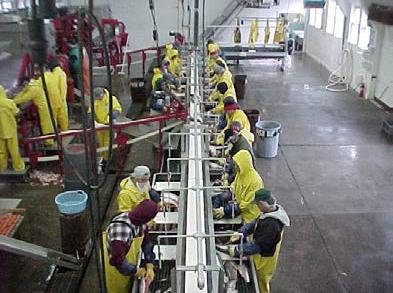Seafood Processing Effluent Guidelines
 EPA promulgated the Seafood Processing Effluent Guidelines and Standards (a.k.a. Canned and Preserved Seafood Category; 40 CFR Part 408) in 1974 and 1975. The regulation covers wastewater discharges from facilities that preserve and can seafood. The Seafood Processing Effluent Guidelines and Standards are incorporated into NPDES permits.
EPA promulgated the Seafood Processing Effluent Guidelines and Standards (a.k.a. Canned and Preserved Seafood Category; 40 CFR Part 408) in 1974 and 1975. The regulation covers wastewater discharges from facilities that preserve and can seafood. The Seafood Processing Effluent Guidelines and Standards are incorporated into NPDES permits.- What is Seafood Processing?
- Facilities Covered
- Alaskan Seafood Processing—1981 Proposed Rule
- Rulemaking History
- Additional Information
What is Seafood Processing?
Seafood preserving and canning facilities receive raw or frozen seafood from harvesting operations (e.g. fishing, trapping, netting). The facilities prepare the seafood products by butchering and cleaning. Prior to packaging, the seafood may be preserved typically by curing, cooking, or freezing. Wastewater may be generated from each stage in the process.
These activities are included within NAICS codes 311711, Seafood Canning, and 311712, Fresh and Frozen Seafood Processing. (Note: the NAICS group listing is provided as a guide and does not define the coverage of the Seafood Processing regulations. For precise definitions of coverage, see the applicability sections in 40 CFR Part 408.)
Facilities Covered
The Seafood Processing effluent guidelines apply to preserving and canning facilities in 33 subcategories:
- Farm-Raised Catfish
- Conventional Blue Crab
- Mechanized Blue Crab
- Non-Remote Alaskan Crab Meat
- Remote Alaskan Crab Meat
- Non-Remote Alaskan Whole Crab & Crab Section
- Remote Alaskan Whole Crab & Crab Section
- Dungeness & Tanner Crab in the Contiguous States
- Non-Remote Alaskan Shrimp
- Remote Alaskan Shrimp
- Northern Shrimp in the Contiguous States
- Southern Non-Breaded Shrimp in the Contiguous States
- Breaded Shrimp in the Contiguous States
- Tuna
- Fish Meal
- Alaskan Hand-Butchered Salmon
- Alaskan Mechanized Salmon
- West Coast Hand-Butchered Salmon
- West Coast Mechanized Salmon
- Alaskan Bottom Fish
- Non-Alaskan Conventional Bottom Fish
- Non-Alaskan Mechanized Bottom Fish
- Hand-Shucked Clam
- Mechanized Clam
- Pacific Coast Hand-Shucked Oyster
- Atlantic & Gulf Coast Hand-Shucked Oyster
- Steamed & Canned Oyster
- Sardine
- Alaskan Scallop
- Non-Alaskan Scallop
- Alaskan Herring Fillet
- Non-Alaskan Herring Fillet
- Abalone
Alaskan Seafood Processing—1981 Proposed Rule
On May 19, 1980, in response to a petition received by a portion of the industry, EPA suspended the stricter effluent limits based on screening technology for Anchorage, Cordova, Juneau, Ketchikan, and Petersburg, and instead subjected processors in those areas to the limits for remote locations based upon grinding. On January 9, 1981, EPA proposed revisions to subparts related to certain on-shore processors in Alaska, in response to petitions received from the industry. In 2010, EPA sent questionnaires to seafood processing in Anchorage, Cordova, Juneau, Petersburg, Dutch Harbor, Ketchikan, and the Kenai Peninsula, and subsequently conducted supporting analyses of the data. In 2013 EPA announced the availability of data and supporting analyses, provided preliminary indications of how the results may be reflected in amended effluent limitations, and solicited public comments.
In July 2017, EPA decided not to amend subparts of the Canned and Preserved Seafood Processing Category related to certain on-shore processors in Alaska. The Agency made this decision in light of the fact that all of the facilities subject to this rulemaking are located in the state of Alaska and EPA concludes that the State of Alaska will establish additional water pollution controls at these facilities if and where the State determines such controls are appropriate and necessary. EPA will continue to work with the state as they consider appropriate controls through their permitting actions. Under 40 CFR Part 408, the limitations for Anchorage, Cordova, Juneau, Ketchikan and Petersburg based upon grinding remain in effect.
The notices related to these activities are available in the Rulemaking History section. Other related documents are available in the rulemaking docket at regulations.gov. The docket number is EPA–HQ–OW–2013–0652.
Rulemaking History
2013 Notice of Data Availability
- Notice of Data Availability (November 7, 2013)
1981 Proposed Rule
- Federal Register notices (1980-81)
1975 Rulemaking – Phase II
- Documents, including:
- Final Rule (December 1, 1975)
- Development Document
- Interim Final Rule (January 30, 1975)
- Proposed Rule (January 30, 1975)
- Documents, including:
- Final Rule (February 11, 1975)
- Proposed Rule (June 26, 1974)
1974 Rulemaking - Phase I
- Documents, including:
- Final Rule (June 26, 1974)
- Development Document
- Proposed Rule (February 6, 1974)
Additional Information
For additional information regarding Seafood Processing Effluent Guidelines, please contact Meghan Hessenauer (hessenauer.meghan@epa.gov) or 202-566-1040.
